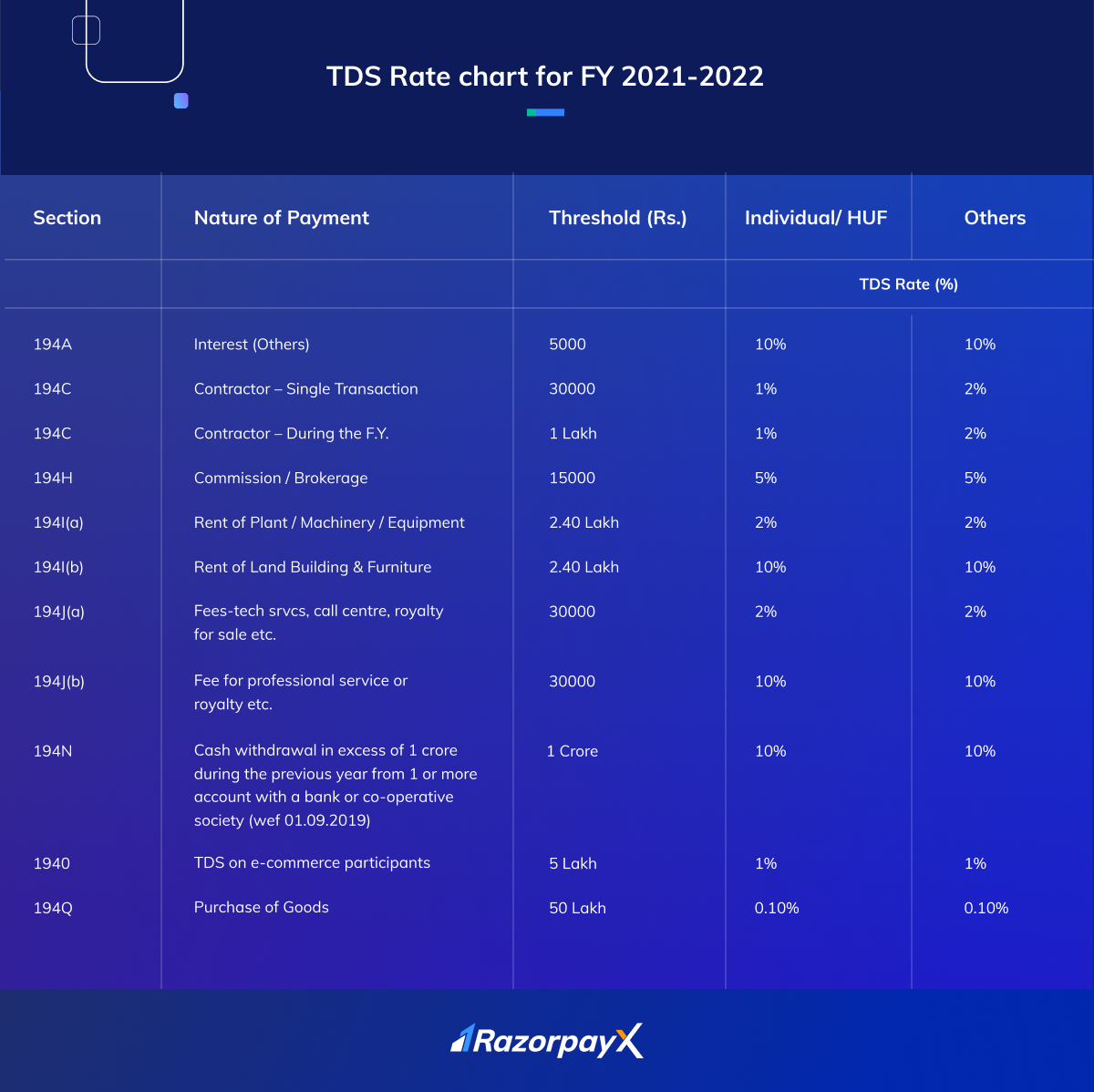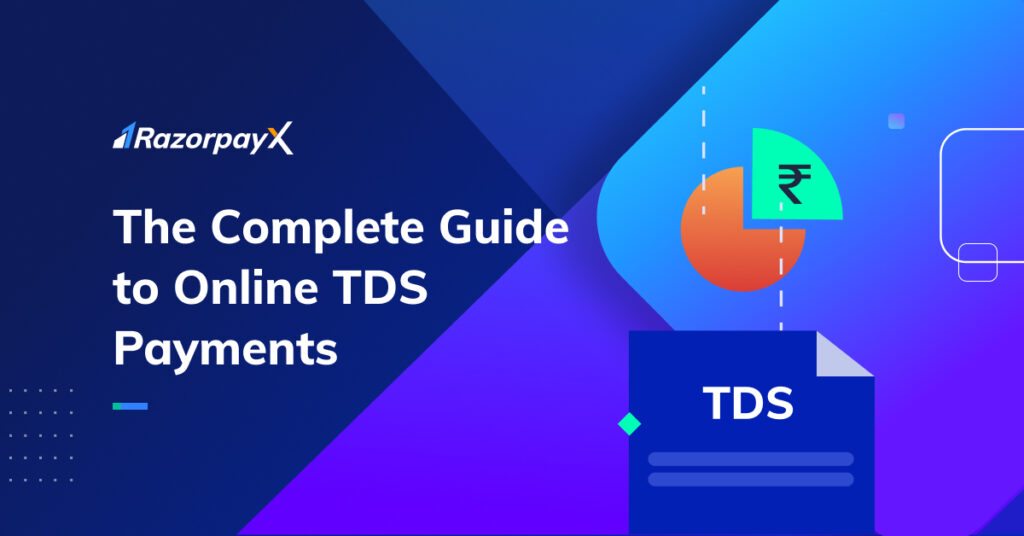Every business is required to deduct TDS (tax deducted at source) before making contractor payments, salary payouts, payments to professionals and more. The Income Tax Department mandates TDS to be collected at specified rates every month.
Read on to know everything about making monthly TDS payments, TDS rates, due dates & penalties for late payments.
What is TDS?
TDS (Tax deducted at source) is a mode of direct tax collection set by the Income Tax Department in India. Every business or individual is required to deduct a certain percentage as TDS before making the full payment to contractors, professionals or employees.
Example for understanding a TDS payment
Let’s say a Private Ltd. Company (Meenakshi) makes a rent payment of Rs 200,000/- to a builder.
Now, Meenakshi Pvt. Ltd. is required to deduct & deposit TDS of Rs 20,000- (10%) to the government and make a net payment of Rs 1,80,000/- to the builder.
What is the process of depositing TDS?
Any individual or business need to deposit TDS to the Central Income Tax Department through TDS Challan 281.
There are two modes of depositing TDS – offline and online (e-TDS) mode.
Offline TDS payment
Deductors can deposit TDS by physically visiting an authorised bank branch and submit the challan. Once the challan is successfully submitted, the bank will issue a stamped receipt or counterfoil as proof of TDS payment.
Online TDS payment
Corporate and non-corporate businesses can deposit e-TDS on the NSDL government portal by following these steps
Step 1: Log in to NSDL’s website
Step 2: From the ‘Services’ tab, select ‘e-payment: Pay Taxes Online’
Step 3: Select the relevant challan i.e. ITNS 281
Step 4: Fill in the challan with all the details:
- Select ‘0020’ for company deductees and ‘0021’ for non-company deductees
- Select whether the TDS payment is to be made by the taxpayer himself or based on an assessment from the income tax department. If it is the former, select “TDS/TCS payable by the taxpayer.” Otherwise, select “TDS/TCS Regular assessment”
- Select the nature of payment for which TDS is to be paid
- Next, choose a payment method, either a debit card or net banking
- Enter your 10 digit Tax Deduction Account Number (TAN)
- Choose the relevant assessment year
- Fill in other details, such as your email address, address, mobile number, etc. And enter the captcha code and click ‘Next’
- Recheck all the information and click on ‘Confirm’
Step 5: Once confirmed, the NSDL portal will direct you to your selected bank’s payment page. Make a TDS payment online by logging into your net banking account
Step 6: On successful payment, the deductor is issued a Challan Identification Number (CIN) which they need to download & store manually as proof of TDS payment
Online TDS payments with RazorpayX
Let’s face it – the above mentioned traditional processes of making TDS payments, both online & offline, take businesses hundreds of hours every year that overlaps with valuable business management time.
That stops today.
Start automating TDS payments for your business with RazorpayX and
- Collaborate with your CA to add the tax payment details & approve the payments seamlessly
- Save time and manual effort using pre-filled tax forms
- Post-payment, store & access all challans from one dashboard
- Get quick processing with customised user experience
Check out the video below to know how.
Pro Tip: You can experience the ease of paying TDS on RazorpayX even without signing up. Try out our new Free RazorpayX TDS payments tool, today!
What are the due dates for making TDS payments?
It is mandatory to collect TDS and deposit it to the government by the 7th of the subsequent month to avoid any penalties.
For example, the TDS payment due date for May will be 7th June.
Note: The due date of depositing TDS for March is 30th April. This extension is provided to accommodate the closing of the financial year.
| Month | TDS payment date |
| April | 7th May |
| May | 7th June |
| June | 7th July |
| July | 7th August |
| August | 7th September |
| September | 7th October |
| October | 7th November |
| November | 7th December |
| December | 7th January |
| January | 7th February |
| February | 7th March |
| March | 30th April |
Make TDS payments online, completely FREE on RazorpayX and avoid late penalties. Pay via multiple payment options including credit card & UPI.
What are the penalties for late and non-deduction of TDS payments
For non-deduction of TDS
Section 201(1A) of the Income Tax Act mandates an interest of 1% per month to be charged for non-deduction of TDS from the date TDS was supposed to be deducted to the actual deduction date.
For non-payment of TDS after the deduction
In the case of late TDS deposition, an interest of 1.5% is applicable from the date of deduction to the payment date.
TDS Rate Chart

What is a TDS Return?
TDS Return is a statement that summarises all TDS related transactions carried out in a quarter. It is mandatory for all the deductors (businesses or individuals) to file the TDS return with the income tax department, quarterly.
Here are the due dates for filing TDS returns.
| Quarter | Due date |
| April-June | 31st July |
| July-September | 31st October |
| October-December | 31st January |
| January- March | 31st May |
Note: The penalty for delay in filing TDS returns after the specified due date under section u/s 234E section is Rs. 200 per day.
Frequently Asked Questions (FAQs) for TDS payments
What is TAN?
Every business deducting TDS needs to obtain TAN (Tax Deduction and Collection Account Number), a 10-digit alphanumeric number from the Income Tax Department and then register themselves as a deductor on the TRACES website.
Note: Providing the wrong TAN in TDS challans, TDS payments and TDS returns might attract a penalty of Rs 10,000 for the deductor.
What is self-assessment tax?
When the taxpayer calculates the income, deductions and exemptions herself/himself, it is regarded as self-assessment tax.
What is regular assessment tax?
The Income Tax Department calculates the regular assessment tax while assessing a taxpayer’s income for a financial year. If any taxes are due, the assessing officer issues an income tax demand, to which the taxpayer must react and pay the taxes due.



